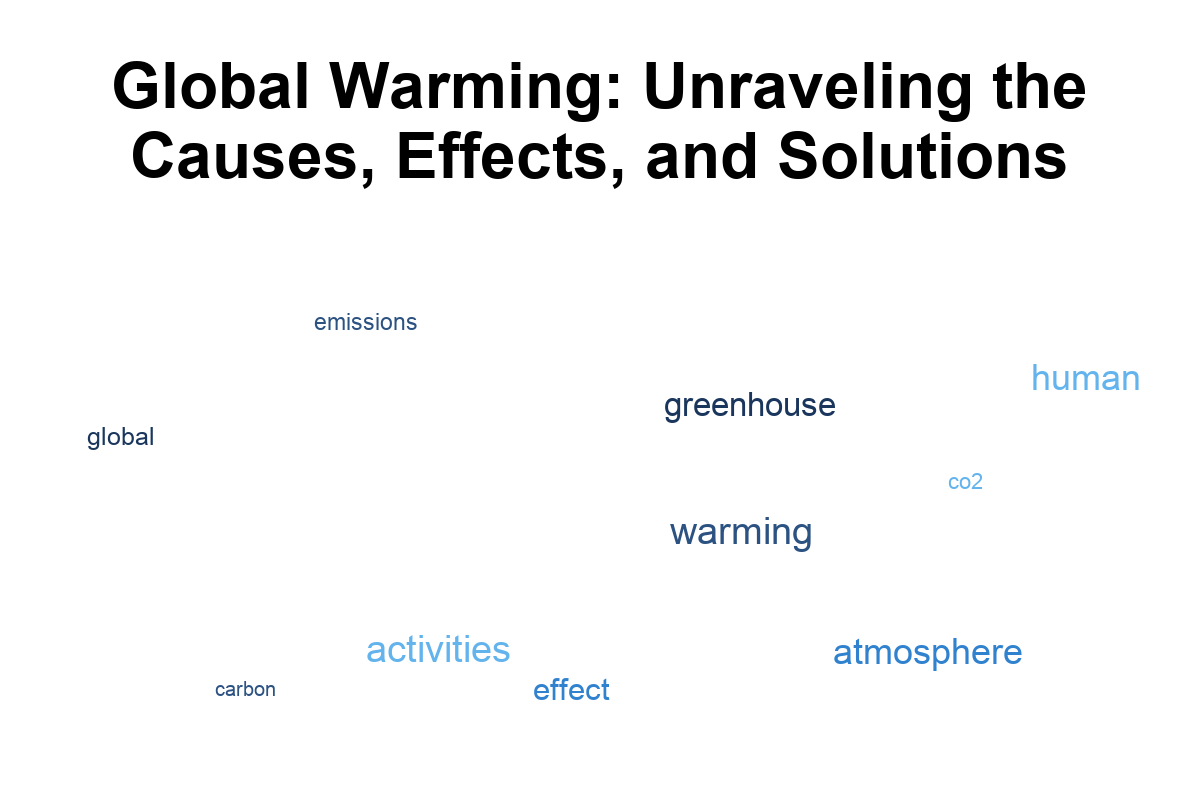The term ‘Global Warming’ has been discussed for many years, but its implications are far more severe than we often realize. The Earth’s average temperature has escalated by 1.62 degrees Fahrenheit since the late 19th century, predominantly due to human activities. This minor increase has triggered a series of environmental issues, from melting polar ice caps to intense wildfires. This article delves into the complexities of global warming, explaining its primary causes, widespread effects, and potential solutions. We’ll examine the role of greenhouse gases, deforestation, and industrialization in fueling global warming, its impact on climate variations, biodiversity, and human life, and the innovative strategies being proposed to mitigate its effects. Prepare for a journey through the alarming reality of our warming planet, offering insights that could inspire us all to become part of the solution.
Understanding Global Warming
Global Warming Defined:
Global warming is the long-term rise in Earth’s average temperature. This trend, observed since the early 20th century, is mainly due to the spike in greenhouse gases in the atmosphere from human activities. The Intergovernmental Panel on Climate Change (IPCC) reports an approximately 1.0°C rise in the global average surface temperature since the pre-industrial era (1850-1900). The warming varies across the globe; the Arctic, for instance, has heated more than twice as fast as the global average. If left unchecked, this trend could lead to severe, widespread, and irreversible impacts on people and ecosystems.
The Greenhouse Effect Explained:
The greenhouse effect is a natural process that warms the Earth’s surface. The process works as follows:
1. Sunlight warms the Earth’s surface.
2. The heated surface emits heat energy back into the atmosphere as infrared radiation.
3. Some of this heat is absorbed by greenhouse gases (like carbon dioxide, methane, and water vapor) in the atmosphere, trapping it and preventing it from escaping into space.
4. This trapped heat warms the Earth’s lower atmosphere and surface, a phenomenon known as the greenhouse effect.
Under normal conditions, the greenhouse effect makes our planet habitable by maintaining an average global temperature around 15°C, suitable for life as we know it. However, human activities, such as burning fossil fuels, deforestation, and industrial processes, have significantly increased these greenhouse gases in the atmosphere, intensifying the greenhouse effect and leading to global warming.
Data from the U.S. Energy Information Administration (EIA) shows that in 2019, the combustion of fossil fuels for electricity and heat was the largest single source of global greenhouse gas emissions, contributing about 30.7% of total CO2 emissions. Moreover, the Global Carbon Project reported that global CO2 emissions from fossil fuels and industry grew by 62% from 1990 to 2019, indicating a significant increase in greenhouse gas emissions.
In conclusion, global warming, driven by the enhanced greenhouse effect due to human activities, presents a major threat to our planet’s ecosystems and species, including humans. It calls for immediate and sustained action to mitigate its impacts. The subsequent sections of this article will delve into the effects of global warming and potential solutions to this looming crisis.
Reasons Behind Global Warming
The Causes of Global Warming:
Global warming involves a multitude of factors, both natural and human-induced. This section will delve into these contributors and explore their impact on the escalating global temperatures.
Subheading: Human Activities Fueling Global Warming
Human activities are largely responsible for the accelerated pace of global warming. These activities release significant amounts of greenhouse gases into the atmosphere, leading to the greenhouse effect. The primary human activities contributing to global warming include:
1. Fossil Fuel Consumption: The largest single source of global greenhouse gas emissions is burning fossil fuels like coal, oil, and natural gas for electricity, heat, and transportation. According to the U.S. Environmental Protection Agency, this activity accounts for about 75% of the total human-made CO2 emissions.
2. Deforestation: When forests are cut down, the beneficial effect of trees absorbing CO2 is lost, and the carbon stored in the trees is released into the atmosphere. The World Resources Institute reports that deforestation contributes to about 15% of global carbon emissions annually.
3. Industrial Processes: Manufacturing and construction can release potent greenhouse gases like hydrofluorocarbons (HFCs), perfluorocarbons (PFCs), and sulfur hexafluoride (SF6). These gases trap more heat than CO2, making them significantly more potent in terms of global warming potential.
4. Waste Production: Landfills are a significant source of methane, a potent greenhouse gas. In addition, waste treatment and disposal activities release CO2 and nitrous oxide.
Subheading: Natural Elements Influencing Global Warming
While human activities are the main drivers of global warming, natural factors also contribute. These include:
1. Solar Radiation: Changes in the Earth’s exposure to the sun’s energy can influence global temperatures. However, NASA states that the sun’s output has only increased slightly over the past century and cannot explain the current rate of global warming.
2. Volcanic Eruptions: Large volcanic eruptions can release substantial amounts of CO2 and other greenhouse gases into the atmosphere. However, the effect is generally short-lived and less significant than human-induced factors.
3. Natural Carbon Cycle Imbalances: The Earth’s carbon cycle involves the transfer of carbon between the atmosphere, land, and oceans. Changes in this cycle due to natural phenomena like forest fires or changes in vegetation can release or absorb CO2, affecting global temperatures.
In conclusion, while natural elements do contribute to global warming, the rapid increase in global temperatures over the last century is primarily due to human activities. Reducing our greenhouse gas emissions is crucial to mitigating the impacts of global warming.
Consequences of Global Warming
The Impacts of Global Warming:
Global warming has significant effects on various aspects of our planet, including weather patterns, biodiversity, and human health.
Effects on Weather Patterns:
Global warming causes drastic shifts in weather patterns, leading to extreme weather events and posing threats to ecosystems and human societies:
1. Increased Temperature: The earth’s average temperature has risen by 1.62 degrees Fahrenheit since the late 19th century, a change largely caused by increased carbon dioxide and other human-made emissions.
2. Melting Polar Ice and Glaciers: The Greenland and Antarctic ice sheets have lost mass. NASA’s Gravity Recovery and Climate Experiment data show that Greenland lost an average of 286 billion tons of ice per year between 1993 and 2016, while Antarctica lost about 127 billion tons during the same period.
3. Rise in Sea Levels: Global sea level rose about 8 inches in the last century. The rate in the last two d [TRUNCATED]
















